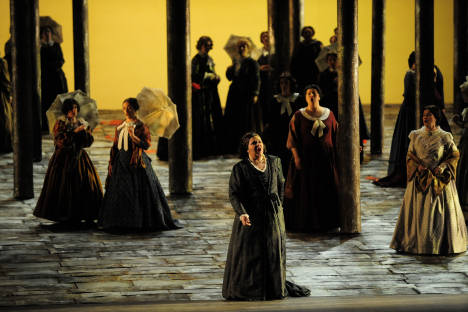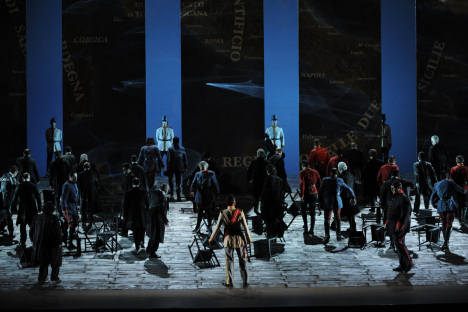Other Links
Editorial Board
- Editor - Bill Kenny
- London Editor-Melanie Eskenazi
- Founder - Len Mullenger
Google Site Search
SEEN
AND HEARD INTERNATIONAL OPERA REVIEW
Verdi, La Battaglia di Legnano:
Orquesta Sinfónica de Bilbao. Coro de Ópera de Bilbao. Conductor:
Renato Palumbo. Palacio Euskalduna de Bilbao. 12.4.2008. (JMI)
New Production for the Friend of Opera in Bilbao (ABAO)
Direction: Emilio Sagi
Sets: Llorenç Corbella
Costumes: Pepa Ojanguren
Lighting: Eduardo Bravo
Cast:
Arrigo: Francisco Casanova
Lida: Alessandra Rezza
Rolando: Ambrogio Maestri
Barbarossa: Marco Spotti
Marcovaldo: Javier Galán
Imelda: Nuria Orbea.
Podestá and Consul : Fernando Latorre

La
Battaglia di Legnano
is an work that almost created a new style, the patriotic/
nationalistic opera. Its composition - as a result of the revolt
known as “Le cinque giornate” by Lombardy against the Austrians
in March of 1848 is Verdi’s patriotic contribution - totally
imbued with the spirit of Risorgimento, - to the glory of
his country then in the process of constructing its new identity.
The premiere in January of 1849 became a national event of first
magnitude and had to take place outside Lombardy –once again under
the Austrian imperial rule – in Rome which had become a point of
encounter for the Italian republicans, headed by Manzini and
Garibaldi. Whether it commes about by convinced patriotism on the
parts of Verdi and his librettist Cammarano or by a sheer
opportunism, the certain thing is that in this opera there are
about 30 references to the then nascent Italian state, with
numerous shouts here and there of “Viva Italia!” included in the
score. The opera is clearly the beginning of a genre - happily
almost without continuation – that can be called patriotic opera.
Within ABAO’s project “Tutto Verdi” we have the opportunity of
seeing all the composer’s rarely performed works during the next
12 years. Last year we were offered Oberto, conte di San
Bonifacio, this year it’s La Battaglia di Legnano,
while next season we shall have both I Due Foscari and Aroldo.
A real treat for the large numbers of Verdi fans in Bilbao.
From a purely musical point of view, it is an irregular work with
many ups and downs. Between the chum-pa-pa of the overture
and the pa-pa-chum of the last scene, there are pages of
great beauty, announcing the genius of Verdi, which was the on the
verge of exploding, extremely clearly By way of Luisa Miller
and Stiffelio we arrive at Rigoletto, whose chorus
of “Cortigiani” is very nearly pre-auditioned in La
Battaglia’s first act. The most likely reason why this opera
has fallen into oblivion is probably its chauvinistic origins
however Such nationalistic and patriotic songs would never be
heard Italy these days except in some very particular
circumstances, which fortunately exist no longer.

Since La Battaglia di Legnano was a product of very precise
historical circumstances, it was a very good idea on the part of
director Emilio Sagi to present the action exactly in the
Risorgimento period, where this opera obviously makes most
sense. Sagi’s brand new production is truly minimalist and
works very well, particularly with the outstanding lighting
designed by Eduardo Bravo. Sagi knows all the possibilities
presented by the Euskalduna stage and takes full advantage of
them. There are beautiful moments, such as the Prayer scene, which
changes by means of lighting effects alone into the brilliant
victorious final scene. This is fine good work by Emilio Sagi,
who proves once again that big sums of money aren’t always need
for an attractive production.
Initially Bruno Bartoletti was announced as musical director, but
he cancelled for personal and not very defensible reasons, that
did not prevent him from conducting La Bohème in Parma
within a few days. The responsibility for the cancellation is only
attributable to Mr. Bartoletti and could easily have created a
problem of first magnitude as the result. Fortune was with ABAO
however as they were able engage Renato Palumbo, a conductor of
some prestige and a full guarantee of high quality. If in other
occasions I have criticized some substitutions in Bilbao, this
time I must praise both the effort involved in finding someone
good and the results of doing so. Renato Palumbo gave an
outstanding performance, taking the work along very rhythmically,
providing every care for the singers and getting a remarkable
performance from the Bilbao orchestra. Nobody missed Maestro
Bartoletti at all: and actually, we his cancellation was an
entirely good thing. The chorus became an outstanding ensemble on
this occasion. And Verdi was very well served by them.
The vocal casting offered more darkness than light, although we
should always recognize how difficult assembling a first class
team for any Verdi opera can be, the more so when the opera
is a rarity. The trio of protagonists brought in for the event
were certainly heavy weights however, but only in terms of
physique unfortunately.
Francisco Casanova was on stage as Arrigo and this was his least
convincing performance to date in Bilbao. If in Poliuto we
discovered that his singing is more than somewhat compromised by
his girth, here the difficulties were even greater, with very
serious problems in vocal projection. He does continue to be a
remarkable singer, particularly in terms of phrasing and
immaculate diction, but I suspect he is at a cross roads with his
career unless he can deliver more power. As things stand. I can’t
see much of a future for him.
Ambrogio Maestri was a good Rolando in vocal terms, although
excessively stiff as an interpreter. His performance was the best
of the trio of prinicpals, showing a good Verdi baritone, which is
a real “rara avis” these days. His forte attacks in the higher
register are coarse and lose quality , which is . a pity because
he does have the notes and sounds exist beautiful when singing
quietly.
Alessandra Rezza fought with the part of Lida and lost. It is
sad to witness her current vocal shape because she has a good
middle register, very well suited for this repertoire, but
sadly she has lost most of her high notes over a remarkably short
period of time, most probably as a result of mistaken choices of
repertoire. Simply, Lida’s tessitura today is too high for her and
frankly her top register was almost painful to hear. She was more
than pleasant in the middle, but the high notes were whitish,
shouted and out of pitch for the most part. The vocal
deterioration is terribly evident and quite understandable when
she sang so many Abigails before she was thirty.
Marco Spotti was a good Barbarossa in his short appearane in the
final scene of the second act and Fernando Latorre offered little
interest as Podestá and the Consul. Nuria Orbea was a weak Imelda
in a role for a mezzosoprano, while she remains a soprano.
Javier Galán was and adequate Marcovaldo.
The theatre had its usual full house but there was little
enthusiasm among the audience, except for Rolando’s aria in act
III. At the final bows, the biggest applause went to Messrs Sagi,
Palumbo and Maestri.
Pictures © E. Moreno Esquibel
Back
to Top
Cumulative Index Page
